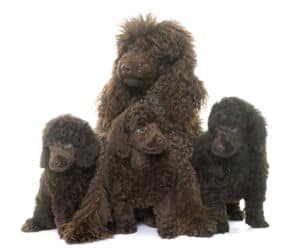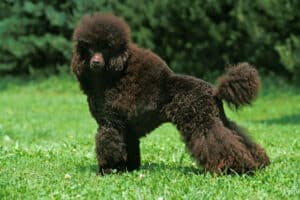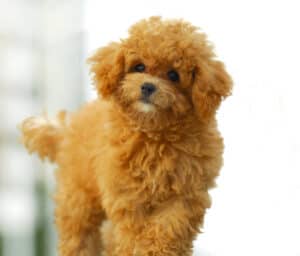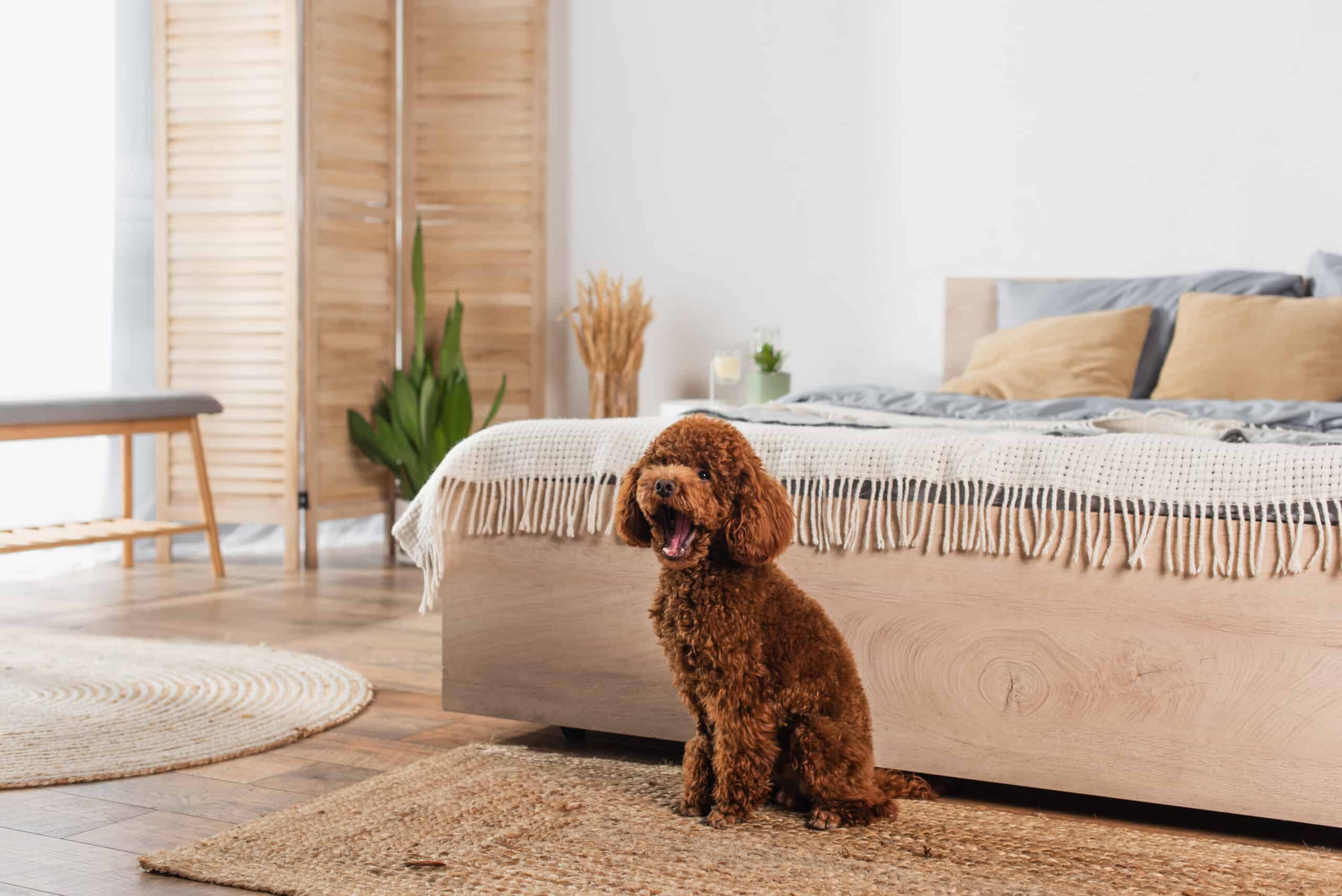If you’re an allergy sufferer and are thinking about getting a Poodle, you might be wondering, “are Poodles hypoallergenic?”
Poodles are a popular dog breed known for their intelligence, loyalty, and unique curly coat.
However, for some people, allergies can be a concern when considering a Poodle as a pet.
Many people believe that Poodles are hypoallergenic, but is this really true? The great news is YES, Poodles are hypoallergenic!
Table of Contents
Understanding Hypoallergenic
Many people don’t understand exactly what hypoallergenic means.
The term hypoallergenic is often used to describe dog breeds that produce less allergens which makes them less likely to cause an allergic reaction in people.
However, it’s important to note that no dog breed is completely allergy-free. All dogs produce dander, saliva, and urine, which can trigger allergies in some people.
What is dander? Dander is made up of tiny flakes of skin that are shed by dogs and other animals.
Allergens in dander are carried through the air and can cause allergic reactions when they come into contact with a person’s skin or respiratory system.
When someone with allergies comes into contact with an allergen, their body produces histamines, which can cause a variety of symptoms such as sneezing, itching, watery eyes, and runny nose.
In some cases, allergies can also lead to more serious reactions such as hives, difficulty breathing, and even anaphylaxis.
The immune system of a person with allergies mistakenly identifies certain proteins in the allergen as harmful, triggering an allergic reaction.
In the case of dogs, the proteins are found in their saliva, urine, and dander.
Poodles and Allergies – Are Poodles Hypoallergenic?

While no dog breed is completely hypoallergenic, some breeds are known to produce fewer allergens than others.
Poodles are often cited as one of the most well-known hypoallergenic dog breeds.
They have curly hair that holds less dander and also sheds less than other breeds, reducing the allergen exposure to pet owners.
This is because the hair traps dander and keeps it from becoming airborne.
Additionally, Poodles produce less of a certain protein called Can f 1 in their skin, saliva, and urine, which is a common allergen for people with dog allergies.
It is important to note that while Poodles are hypoallergenic, some people may still have an allergic reaction to them.
However, the severity of the reaction can vary between individuals. It is essential to spend time around a Poodle to see if an allergic reaction occurs before making a commitment to own one.
If you are a Poodle owner and have allergies, there are steps you can take to reduce your exposure to allergens.
Regularly vacuum your home, including furniture and upholstery your poodle frequents, to remove pet dander and hair.
Use an air purifier with a HEPA filter to reduce allergens in the air.
Wash your Poodle’s bedding weekly with hypoallergenic detergents to eliminate any allergens that may be lurking there.
Additionally, it is important to keep your Poodle clean and groomed to minimize shedding and dander.
Grooming and Allergy Management
Regular grooming is essential for managing allergies in Poodles.
By keeping a Poodle’s coat clean and well-maintained, pet owners can reduce the amount of dander and other allergens that are shed into the environment (although Poodles produce much much less than most other breeds).
Brushing a Poodle’s coat at least every other day, if not daily, is recommended to remove loose hair and prevent matting.
Using a slicker brush and metal comb can help to remove tangles and prevent mats from forming.
When brushing, it is important to pay attention to areas where mats are most likely to occur, such as behind the ears, under the legs, and around the tail.
Bathing a Poodle every three to four weeks can also help to reduce allergens.
Using a hypoallergenic shampoo and conditioner can help to soothe the skin and reduce itching.
It is important to thoroughly rinse the coat to remove all soap residue, as leftover soap can cause skin irritation and increase dander production.
Vacuuming and dusting regularly can also help to manage allergies. Using a vacuum with a HEPA filter can help to capture allergens that are floating in the air.
Dusting with a damp cloth can help to trap allergens and prevent them from becoming airborne.
Poodle Hair and Shedding
Poodles are often considered hypoallergenic dogs, but this does not mean they do not shed at all.
Like any other dog, Poodles go through a cycle of hair growth and loss, but they shed considerably less than other breeds.
Poodles have a single coat of curly hair that grows continuously, which is why they require regular brushing and clipping to keep it in a manageable length.
Poodle hair is different from fur, which is why poodles are often described as low-shedding dogs.
Unlike fur, hair grows to a certain length and then falls out on its own, while fur grows continuously and sheds constantly.
Poodle hair also has an undercoat, but it is not as thick as that of other breeds, and it does not shed as much.
Poodle Breeds and Their Differences
While all Poodles share some common traits, there are actually three different sizes recognized by the American Kennel Club: standard, miniature, and toy.
Each size has its own unique characteristics and temperament.

The Standard Poodle is the largest of the three sizes, standing at over 15 inches tall at the shoulder. They are known for their intelligence, athleticism, and trainability.
Standard Poodles are often used as show dogs or for various types of work, such as hunting or search and rescue.

Miniature Poodles, on the other hand, are smaller in size, standing between 10 and 15 inches tall at the shoulder.
They are just as intelligent and trainable as their larger counterparts, but are often kept as companion dogs due to their smaller size.
Miniature Poodles are also a popular breed for dog shows.

Toy Poodles are the smallest of the three sizes, standing less than 10 inches tall at the shoulder.
They are often kept as lap dogs and are known for their affectionate and playful nature.
Toy poodles are also popular in dog shows, particularly in the toy group.
Frequently Asked Questions
What makes Poodles a hypoallergenic breed?
Poodles are considered hypoallergenic because they have hair instead of fur. This means that they shed less dander, which is the primary cause of pet allergies.
Additionally, Poodles produce less saliva than other breeds, which can also be an allergen.
Do Poodles shed a lot?
Poodles shed very little compared to other breeds, but they still shed to some extent.
However, their hair tends to get trapped in their curly coats, which means that it doesn’t end up all over your furniture and clothes.
Can Poodles be a good choice for allergy sufferers?
Yes, Poodles can be a good choice for allergy sufferers. However, it’s important to note that no dog breed is completely hypoallergenic.
Some people may still have an allergic reaction to Poodles, but they are generally less likely to cause allergies than other breeds.
What is the shedding frequency of Toy Poodles?
Toy Poodles shed less than Standard Poodles, but they still shed to some extent. Their shedding frequency is usually once or twice a year.
Are there any other hypoallergenic dog breeds to consider?
Yes, there are several other hypoallergenic dog breeds to consider, such as the Bichon Frise, Maltese, and Schnauzer.
However, it’s important to note that each person’s allergies are unique, so what works for one person may not work for another.
Are Poodles suitable for families with kids who have allergies?
Yes, Poodles can be a good choice for families with kids who have allergies.
However, it’s important to supervise interactions between the dog and the child to ensure that the child doesn’t have an allergic reaction.
Additionally, it’s important to teach children how to interact with dogs in a safe and respectful manner.

